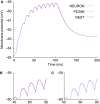PyNN: A Common Interface for Neuronal Network Simulators
- PMID: 19194529
- PMCID: PMC2634533
- DOI: 10.3389/neuro.11.011.2008
PyNN: A Common Interface for Neuronal Network Simulators
Abstract
Computational neuroscience has produced a diversity of software for simulations of networks of spiking neurons, with both negative and positive consequences. On the one hand, each simulator uses its own programming or configuration language, leading to considerable difficulty in porting models from one simulator to another. This impedes communication between investigators and makes it harder to reproduce and build on the work of others. On the other hand, simulation results can be cross-checked between different simulators, giving greater confidence in their correctness, and each simulator has different optimizations, so the most appropriate simulator can be chosen for a given modelling task. A common programming interface to multiple simulators would reduce or eliminate the problems of simulator diversity while retaining the benefits. PyNN is such an interface, making it possible to write a simulation script once, using the Python programming language, and run it without modification on any supported simulator (currently NEURON, NEST, PCSIM, Brian and the Heidelberg VLSI neuromorphic hardware). PyNN increases the productivity of neuronal network modelling by providing high-level abstraction, by promoting code sharing and reuse, and by providing a foundation for simulator-agnostic analysis, visualization and data-management tools. PyNN increases the reliability of modelling studies by making it much easier to check results on multiple simulators. PyNN is open-source software and is available from http://neuralensemble.org/PyNN.
Keywords: Python; computational neuroscience; interoperability; large-scale models; parallel computing; reproducibility; simulation; translation.
Figures



Similar articles
-
ANNarchy: a code generation approach to neural simulations on parallel hardware.Front Neuroinform. 2015 Jul 31;9:19. doi: 10.3389/fninf.2015.00019. eCollection 2015. Front Neuroinform. 2015. PMID: 26283957 Free PMC article.
-
A configurable simulation environment for the efficient simulation of large-scale spiking neural networks on graphics processors.Neural Netw. 2009 Jul-Aug;22(5-6):791-800. doi: 10.1016/j.neunet.2009.06.028. Epub 2009 Jul 2. Neural Netw. 2009. PMID: 19615853
-
Topographica: Building and Analyzing Map-Level Simulations from Python, C/C++, MATLAB, NEST, or NEURON Components.Front Neuroinform. 2009 Mar 24;3:8. doi: 10.3389/neuro.11.008.2009. eCollection 2009. Front Neuroinform. 2009. PMID: 19352443 Free PMC article.
-
GPUPeP: Parallel Enzymatic Numerical P System simulator with a Python-based interface.Biosystems. 2020 Oct;196:104186. doi: 10.1016/j.biosystems.2020.104186. Epub 2020 Jun 11. Biosystems. 2020. PMID: 32535178 Review.
-
Interoperability of neuroscience modeling software: current status and future directions.Neuroinformatics. 2007 Summer;5(2):127-38. doi: 10.1007/s12021-007-0004-5. Neuroinformatics. 2007. PMID: 17873374 Free PMC article. Review.
Cited by
-
SpineCreator: a Graphical User Interface for the Creation of Layered Neural Models.Neuroinformatics. 2017 Jan;15(1):25-40. doi: 10.1007/s12021-016-9311-z. Neuroinformatics. 2017. PMID: 27628934 Free PMC article.
-
Brian2Loihi: An emulator for the neuromorphic chip Loihi using the spiking neural network simulator Brian.Front Neuroinform. 2022 Nov 9;16:1015624. doi: 10.3389/fninf.2022.1015624. eCollection 2022. Front Neuroinform. 2022. PMID: 36439945 Free PMC article.
-
Simulation Neurotechnologies for Advancing Brain Research: Parallelizing Large Networks in NEURON.Neural Comput. 2016 Oct;28(10):2063-90. doi: 10.1162/NECO_a_00876. Epub 2016 Aug 24. Neural Comput. 2016. PMID: 27557104 Free PMC article.
-
NeuroConstruct-based implementation of structured-light stimulated retinal circuitry.BMC Neurosci. 2020 Jun 24;21(1):28. doi: 10.1186/s12868-020-00578-0. BMC Neurosci. 2020. PMID: 32580768 Free PMC article.
-
Empirical Bayesian significance measure of neuronal spike response.BMC Neurosci. 2016 May 21;17(1):27. doi: 10.1186/s12868-016-0255-x. BMC Neurosci. 2016. PMID: 27209433 Free PMC article.
References
-
- Brette R., Rudolph M., Carnevale T., Hines M., Beeman D., Bower J., Diesmann M., Morrison A., Goodman P. H., Harris F., Jr, Zirpe M., Natschlager T., Pecevski D., Ermentrout B., Djurfeldt M., Lansner A., Rochel O., Vieville T., Muller E., Davison A., El Boustani S., Destexhe A. (2007). Simulation of networks of spiking neurons: a review of tools and strategies. J Comput. Neurosci. 23, 349–39810.1007/s10827-007-0038-6 - DOI - PMC - PubMed
-
- Carnevale N. T., Hines M. L. (2006). The NEURON Book. Cambridge, University Press.
-
- Crook S., Beeman D., Gleeson P., Howell F. (2005). XML for model specification in neuroscience: an introduction and workshop summary. Brains Minds Media 1, bmm228 (urn:nbn:de:0009–3–2282).
LinkOut - more resources
Full Text Sources
Other Literature Sources

